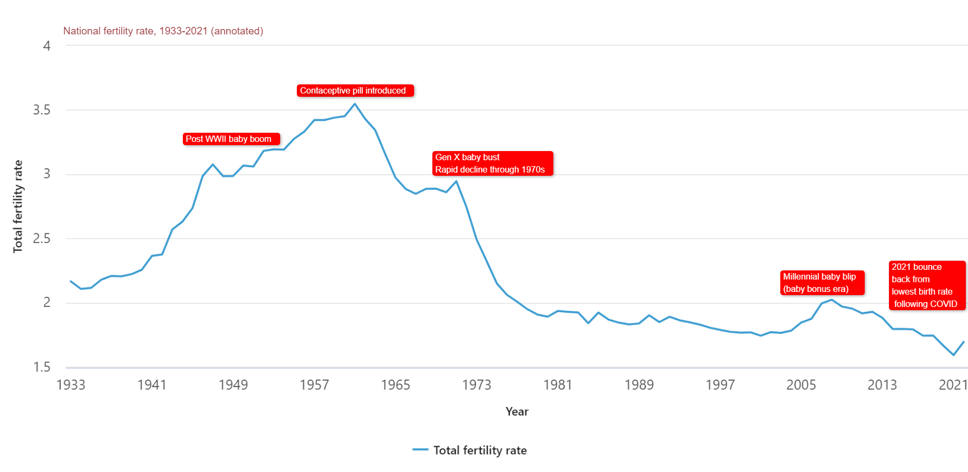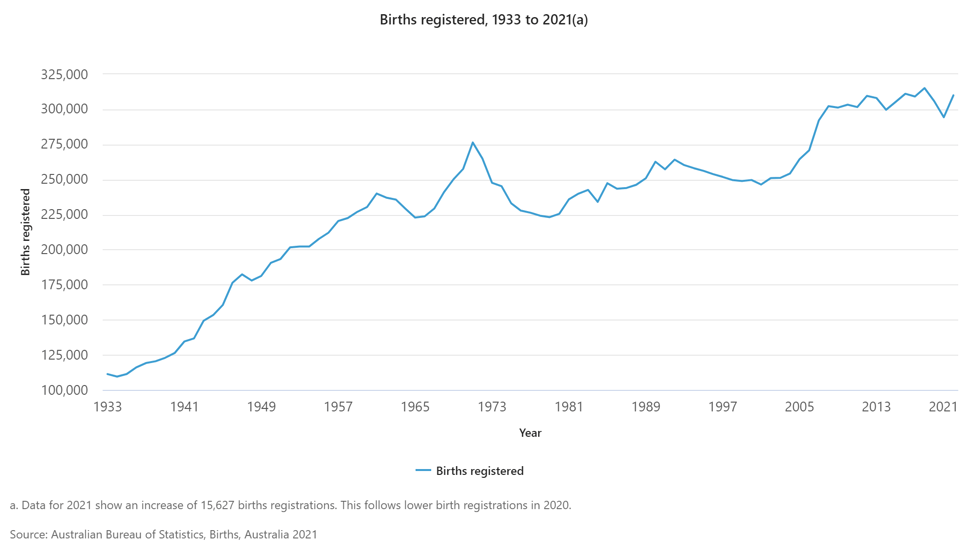The birth rate for Australia has increased for the first time in nearly a decade. Glenn unpacks the history of Australia’s declining birth rate, how this new data affects that story, and the role COVID-19 played in this increase.
New and eagerly awaited data on the birth rate during the pandemic has been released by the ABS. It shows that Australia’s birth rate has increased for the first time since 2012, following a decade of declines. It’s still pretty low in historical terms, but did increase a little during COVID as many were predicting.
In the calendar year 2021, Australia’s birth rate (technically “Total Fertility Rate” or TFR) stood at 1.70. This was an increase from the record low of 1.59 in the 2020 calendar year, and the first increase in the rate we’ve seen since 2012, when the rate began to fall after the “baby bonus” era children of the early-mid 2000s.
The TFR is a somewhat theoretical measure that represents the average number of children a woman would have in her lifetime, based on the age-specific fertility rates in a given year.
Australia’s birth rates have been declining since the 1960s
In the last century, birth rates were highest during the post–World War II baby boom, peaking at 3.55 in 1961 before falling over many years as contraception became widely available, women entered the workforce in greater numbers, and we began to have children much later in life. Apart from a blip (2.02) in 2009 caused by the baby bonus era and a high migration rate of young people into the country, the rate has been below 2.0 since 1977, and shows no signs of returning to that level. The TFR of 2 is important, as it represents something close to “replacement level” – the idea that 2 children would replace the mother and father in the long-term. (Actual replacement level is usually assumed to be a bit more than 2, around 2.05 or 2.1, allowing for infant mortality, but this is very low in Australia at the moment).

Original source: ABS, Births, Australia, 2021 (annotations by .id)
The number of births in Australia have been increasing
The TFR is the theoretical measure. But in practical terms there were 309,996 births registered in Australia during 2021, up by over 15,000 from the previous year, but still below the record high number of 315,147 recorded in 2018. This is important to remember. There are more births now than there were at the peak of the baby boom, just because our population is so much larger now. The peak year of 1961 recorded 239,000 births, but the population was only about 10 million, less than half what it is now.
The chart of actual birth numbers over time is straight from the ABS births publication.

Neither of these charts start at zero so they may be a little misleading in the magnitude of change.
Would Australia’s population be declining without migration?
While a TFR of just over 2 is considered replacement level, it’s a common misconception that – with our TFR below 2 – our population would be declining without migration. We currently have a large population of childbearing age (TFR is calculated for a standardised age structure) and substantially more births than deaths. So even without migration, Australia would be growing for many years yet. But eventually, with no migration and a low birth rate, the population would start to decline. This would still take another 20 to 30 years, though. The very low population growth seen in 2020-21 had more to do with net migration being negative due to people leaving in the pandemic.
Australia’s fertility rates by State and Territory
The fertility rate varies a lot by state. All states had an increase in fertility in 2021, but remain well below the levels recorded a decade ago, at the height of the baby blip. Interestingly, Victoria and the ACT have the lowest rates, and also had among the smallest increases in the last year.
Total Fertility Rate by State/Territory, selected years
All States and Territories have rates below replacement level, with the NT coming closest at 1.82. This is due in part to the large Aboriginal and Torres Strait Islander population. This group has a much higher fertility rate, at 2.34 in 2021 (so above replacement level) and this is one explanation for the large increase in population identified as Aboriginal and Torres Strait Islander at the last Census. (The other being greater propensity to identify with this group over time.)
What impact did COVID-19 have on Australia birth rate?
So, did COVID lockdowns have an impact on increasing the birth rate, as many predicted? The rate certainly went up nationally, but only a little – it’s still quite low relatively. And Victoria, as the most locked-down state increased by a smaller amount than most others, so it would be hard to say that it had much effect. It’s likely that 2020 was artificially low for other reasons and it’s just bounced back towards the trend line for now.
Another interesting fact from the births data is that the rate of births to teenage women continues to fall; as a nation we now have children much later in life than we used to. The median age at birth for all mothers in 2021 was 31.7 years, while for fathers it was 2 years older (33.7 years). 50 years ago, in the early 1970s, the median age of mother was around 25, so it has increased by about 7 years since then.
Birth rates are not directly shown in .id’s community profile but they are a key input into the our local population forecasts, and can have a significant impact on the age of the population in your area.











